DIY sofa bed: diagrams, drawings and step-by-step creation instructions
Most pieces of upholstered bedroom furniture are simple in design. If making a wardrobe, wall or wardrobe will require certain knowledge and skills of a carpenter, then making a chair or sofa bed with your own hands is easier. You just need to make a frame and cover the back and base of the sofa with soft upholstery.
The content of the article:
Design Features
In practice, things are more complicated. The design of a homemade folding sofa bed must at least meet 3 main criteria:
- Unfolds and folds without the use of additional tools.
- Have sufficient stability both in the folded and unfolded position.
- For construction at home, you can use any parts and mechanisms, except for ready-made parts of a sofa bed made in a factory.
This last point means that the process is a reassembly of the original design, rather than a complete overhaul of factory furniture. Since it is almost impossible to build a full-fledged sofa bed with your own hands without pillows, a mattress, backrest lining and armrests, all the soft parts can be borrowed from old sofas, armchairs, and beds.
Photo examples
The simplest sofa bed is assembled from pallets. Each Euro pallet will need to be sanded and varnished. In essence, this sofa bed design resembles a toy construction set.You can stack the pallets one on top of the other, add a fixed backrest to the bottom row, and you’ll get a sofa.
If you lay pallets on the floor, you will get a stacked podium, and after laying pillows, it is quite possible to use it as a sleeping place or a double bed.
The option with pallets can be used as additional sleeping furniture in the country or even as a place to relax on the veranda of a private house.
Furniture with a pull-out bed is more suitable for an apartment. In fact, this is a classic version of a sofa bed with a sliding design, which is mass-produced by furniture workshops and enterprises.
When assembled, the sofa bed is practically no different from ordinary upholstered furniture. In order to bring it into a sleeping position, you need to remove the pillows (they also serve as upholstery for the backrest) and extend the front pillar.
The sofa bed can be made according to the scheme with a reinforced sleeping place. In this case, the seat can be moved, but with a slight lifting of this part of the body. The back simply tilts over into the free space.
The sofa bed looks simple, but the movable part of the body is mounted on a special support, making it easier to lift. The mechanism diagram is quite complex; making a support with your own hands is most likely impossible. But in general, the idea is interesting, so building a sofa bed of a similar design makes sense only if there are parts from old furniture left.
Another project for a homemade sofa bed, the design of which is also used in the industrial production of bedroom furniture. This is a fold out sofa bed.
When folded, it resembles a small children's sofa with a high seating position.Approximately such models, similar to couches, are often installed in rest rooms, and even in living rooms in front of the TV.
To expand the sofa bed, you need to:
- Remove pillows.
- Recline the backrest and place it on folding support legs.
- Lift and turn the upper part of the sofa seat toward you. The side rails are used as supports for the folded section of the sofa bed.
This is one of the most successful designs, but it cannot be called easy to manufacture. The soft part of the seat of the sofa bed also folds out, so it needs to be spread over the entire surface of the bed.
The most unusual model of a folding bed can be called the design shown below. This is a completely original project in which the double bed is folded with its sides inward.
To turn it into a full-fledged sofa bed, you just need to add a backrest, soft pillows and seat upholstery to the design. In addition, you will need a mattress and a set of bedding.
Schemes and drawings
A folding sofa bed does not have to be large. It may well be a single bed with the possibility of increasing the width of the bed due to the reclined backrest.
If you look at the photos and drawings of a folding sofa or accordion, it becomes clear that the backrest is the most difficult to manufacture.
It consists of 2 parts, which makes it possible not only to lay it down, but at the same time to increase the width of the sleeping area of the sofa bed.
A sliding version of bedroom furniture can be built using a frame scheme. The base of the sofa bed is made in the shape of a box.
To make the frame, a wooden beam 45x45 mm is used. The frame of the back of the sofa bed is also assembled from it.If necessary, the frame and frame can be welded from a 25x25 mm profile pipe. The structure will be a little heavier, but more stable and rigid.
It is better to make the back from lumber, cover it with plywood and sheets of foamed polypropylene. The sides can be made in any way you like; you can even use parts from an old chair. Reupholster and put on a sofa bed.
It is better to make the retractable part from thick plywood or knock it down from 45x45 mm bars. This is the most vulnerable part of the sofa bed; it will have to be moved regularly, so the durability of the furniture depends on the strength of this part. According to the plan, it should move on plastic support wheels, but in practice this scheme does not work very well due to deformation and jamming of the wheels.
The sofa bed can be built using a folding design.
The base of the sofa is a box assembled from 2 backs of two sidewalls (joists). The parts are connected to each other using steel angles and self-tapping screws.
The most complex folding part of the sofa bed is a U-shaped frame, the upper part of which is used as a backrest (in the folded position), and the seat frame is attached to the lower part. The connection is made using studs or self-tapping screws. This whole butterfly-shaped structure is fixed to the backrests using screw-in pins, they work like turning axes.
It is clear that this is only a wooden frame for a sofa bed; you will also need to make fabric lining and soft pillows.
For your first experience making a sofa bed, it is best to choose a relatively simple sliding furniture design. This design does not have complex rotating units, hangers or supports, so it can be made even with minimal carpentry experience.
What tools and materials will be needed
For a sofa bed, it is best to use thick plywood 18-20 mm. It makes the most durable furniture. But the high cost of plywood sheets sometimes prevents the entire structure from being made of plywood. To reduce the cost of building a sofa bed:
- The main parts of the box are made from wide (35-40 cm) boards 30-40 mm thick.
- For the frame under the seat and sheathing, pine beams 50x50 mm or 75x50 mm are used.
The boards used to make the sofa bed must be perfectly flat. You need to pay special attention to this fact when purchasing material. Otherwise, the furniture panel, glued together from boards, will be uneven. Therefore, before starting construction of the sofa bed, the purchased material will need to be planed on a machine, both along the planes and along the end surfaces.
In addition, you will need wood glue, self-tapping screws, furniture screws with a conical head, pegs for cutting dowels, and an impregnating wax composition. It is used for bedroom furniture installed on verandas or covered terraces.
To form the soft part of the seat and back of the sofa bed, you will need to sew pillows or make a mattress based on polypropylene foam with a thickness of 60-70 mm. For a homemade sofa bed, you can sew a soft lining stuffed with scraps of non-woven fabric or foam rubber.
It would be possible to use 20mm plywood, this would even reduce the overall weight of the sofa bed. But the appearance of the furniture would clearly be less expressive, since wood after waxing and polishing looks much more attractive than plywood.
For manufacturing you will need a fairly large list of tools:
- Carpentry workbench.
- Table saw or jigsaw.The thickness of the blanks for making sidewalls and backs is 25-40 mm, so you will need a powerful tool.
- Electric drill with a set of regular and cylindrical drills.
- Set of carpentry clamps from 120 mm to 700 mm.
- A carpenter's hammer with a rubber or silicone tip.
- Sanding machine with abrasive belt element. You can additionally use a vibrating grinder for finishing operations. Car disk models can also be used, but they leave risks on the surface of the wood.
- A vice in which workpieces up to 100 mm thick can be secured.
- A jig block or square for drilling oblique holes.
In addition, you will need a marking tool - calipers, tape measures, carpenter's squares, markers.
What kind of glue can I use?
Now the important point is the glue. To glue the parts of the sofa bed, you can use any modern carpentry adhesive. It is better if it is polyurethane based. Solid adhesive compositions cannot be used. Fixation with glue should remain plastic. Polyester or epoxy adhesives hold up well after hardening, but after a couple of months the adhesive seam tears off the top layer of wood and the joint falls apart.
The exception is casein glue, which is absolutely safe and non-toxic. The granules are diluted in cold water and heated in a metal container in a water bath. It is diluted an hour before work; as a rule, a 200 ml jar is enough to glue all the parts.
Casein glue can be made in 5 minutes. According to the recipe, you need to mix 100 grams of cottage cheese with 40 ml of ammonia. The result is a transparent viscous mass that can perfectly glue and putty any wood.
Sofa bed assembly technology
Any cabinet furniture according to existing standards can be assembled either using a classic tongue-and-groove connection, or using wooden pins or dowels.
For assembling the body of a homemade sofa bed, the first option would be more preferable, since the tongue and groove provides higher torsional or bending rigidity. But this method is quite complicated for the first experiments in building bedroom furniture. Therefore, assembly operations are performed on dowels, with gluing of the joining surfaces with casein (or any polyurethane) glue.
It is impossible to assemble and join parts using self-tapping screws alone, even if the main elements are made of plywood. Using self-tapping screws, a sofa bed, chairs, armchairs will last a maximum of several months, after which it is quite difficult to repair the furniture due to cracks.
The process of sheet docking is labor-intensive. For example, to end connect 2 boards using dowels, you need to drill holes in both parts.
The main difficulty is to drill the hole correctly. It must correspond to the diameter of the dowel or be 0.1 mm smaller (for adhesive fitting). In addition, the axis of the hole must be strictly perpendicular to the end surface. Therefore, for drilling, special guides are used - conductors, which are installed at the drilling point and fixed with a clamp. Holes are also drilled on the second board.
After drilling, dowels (wooden pins) are driven into the holes, and glue is applied to the end surface.
Next, the boards are joined, hammered and tightened with clamps.
The result is a furniture panel from which you can make not only a sofa bed, but any home furniture.
Step-by-step creation instructions
To make an extendable sofa bed, you first need to correctly cut the blanks. Since the frame will be glued together on dowels from forty boards, a tabletop cutting machine with a manually driven circular saw is used for cutting.
There is no other way to cut boards efficiently at home. It is necessary not only to cut the workpieces to size, but also to ensure a right angle between the cutting plane and the surface of the forty board.
In addition, you will need to cut blanks for lathing the plane of the moving part of the sofa bed.
Assembling the box of the fixed part of the sofa bed
The design of the sofa consists of a base part or box and a movable part - a sleeping bag. The fixed part will be glued together from one simple side panel, back and side shelf.
A simple sidewall and back need to be glued together on dowels from two pairs of boards (the blanks are cut to 2x80 cm and 2x210 cm). If connected correctly, both parts of the sofa bed will look as if they were cut from one solid slab of wood.
The workpieces will need to be sanded using a grinder. This will help sand down the seam and remove any remaining glue. There is no need to do any additional putty at the joints of glued boards.
The next step is to try on and make dowels, make holes on the simple sidewall and back. You need to connect the parts at right angles, like in a box or bookshelf.
Preliminary fitting of the sofa bed parts will help you check whether the joint was made correctly and whether mistakes were made. This is where you will see how correctly and efficiently the boards were planed.
Making a side panel with a shelf
This sofa bed piece looks more like a bookcase.You will need to cut 3 pieces of 70 cm and two pieces of 40 cm and 20 cm high from the board. The edges of the workpieces are cleaned with a grinding machine. If possible, it is better to polish the ends of wooden blanks using a felt wheel mounted on a drill.
We assemble the side shelf, like all the parts of the sofa bed, using dowels and glue. After assembly, the body will need to be fixed using carpentry clamps.
During the assembly process, you need to make sure that the tightening force on the clamps is approximately the same, otherwise, if you squeeze at least in one place, cracks may appear.
After the glue has dried, you can try on how the side shelf fits into the back of the sofa bed.
Assembling the sofa bed box
First of all, you need to connect the dowels and glue the back of the sofa bed and a simple side panel. To prevent the joint from coming apart while the glue dries, both parts must be secured using clamps.
The next step is to connect the second edge of the back of the sofa bed with the side shelf. To do this, we move the part to the back, as tightly as possible, then fix it with a clamp and cut out a wooden blank for the sidewall (upper part).
Further:
- We adjust the size to length.
- We drill holes on the workpiece, on the back of the sofa bed and on the side itself.
- We insert the dowels, coat them with glue and tighten the entire block with clamps.
The connection on the dowels must be made not only along the bylt, but also in the middle and bottom boards. Only then will the load be distributed evenly over the entire surface area being glued.
Fastening with dowels works ideally when assembling cabinets and shelves. For a sofa bed, its strength is clearly not enough, since the furniture for sitting and relaxing is subject to heavy loads.
Therefore, as soon as the glue dries, you need to drill six through holes for self-tapping screws on the back side of the back. Drill diameter 3.5 mm. We additionally tighten each side panel to the back with six self-tapping screws. The holes can be filled with wood putty.
The next step is to sew a frame made of 50x75 mm timber inside the box. The sheathing slats and mattress will rest on it.
Using a square and clamps, you will need to adjust the position of all four bars so that the corners are straight, otherwise the entire frame of the sofa bed may be slightly “skewed” to the side.
We sew a spacer beam inside the frame, otherwise the sheathing slats will sag greatly under the weight of people sitting on the sofa bed.
You can sew in 2 longitudinal struts, but with a smaller cross-section, for example, 50x50 mm. The ends of the beams are connected to the frame with oblique inserts of self-tapping screws only after the position of the spacer is aligned with the horizon and the plane of the frame. Tighten one screw on the left and right. That is, a total of 4 screws will hold the spacer.
This is enough for one person weighing up to 70 kg. If a sofa bed is being made for a family, then 4 screws will not be enough to compensate for the deflection of the sheathing slats. Therefore, many craftsmen additionally sew a pair of wooden triangles cut from scrap boards at each end of the spacers.
After filling the timber, all parts of the sofa bed, especially those with which human hands will come into contact, must be processed with a grinding machine. Initially, use coarse sandpaper to remove unevenness at the joints, then sand the wood with fine grain to a smooth surface.
All that remains is to fill the sheathing slats. To cut blanks, it is recommended to use a simple board with a section of 100x20 mm.But in practice, slats of this cross-section can withstand loads only if they are cut from oak or acacia. Ordinary pine or spruce are not strong enough. Therefore, you need to either select a suitable tree, or increase the cross-section to 20x120 mm or 25x120 mm. It is clear that the slats must be free of knots and cracks.
We lay the cut boards on the frame sequentially, in increments equal to the width of the workpiece plus 10-15 mm. To speed up and simplify the process, you can use a template made from a lath with two rubber erasers attached to the end for drawing.
The slats can be secured with self-tapping screws or furniture brackets. In the latter case, you will need a pneumatic stapler or hammer. The fastening strength is low, but the furniture bracket will not split the timber.
If you use self-tapping screws, then, firstly, no longer than 25 mm, and secondly, you will need to drill through holes 4 mm in diameter in the slats. So that the self-tapping screw does not split the strip when screwing it into the body of the beam.
Building the movable part of the sofa
To make the retractable part of the sofa bed, you will need a lath, two 50x75 mm beams and one board, which will simultaneously serve as the side or lower part of the facade.
First of all, you need to secure one of the beams to the outside of the sofa bed's support frame. This can be done with a self-tapping screw, but it is best to use a pair of carpentry clamps. The beam will need to be aligned so that it fits under the ends of the previously laid slats with a small gap of 2-3 mm.
Now comes the hard part, you need to cut the side board to size. Typically, the height of the sleeping area of a sofa bed above the floor level does not exceed 35-37 cm.But since the sofa is homemade, the dimensions were chosen arbitrarily, it may happen that the width of the board (blank) will be less than the level of the slats. Therefore, when cutting out parts, even before assembling the sofa bed, you need to select the widest board and leave it for the side.
We install the finished part on the edge so that it touches the plane of the beam secured with a clamp.
Next, we transfer the markings of the upper edge of the beam onto the board and remove both parts from the frame of the sofa bed. Now you need to secure the beam on the inner surface of the side along the marking line. This will require 5-6 carpentry screws 60-70 mm long.
The next step is to stuff the remaining battens of the sheathing onto the timber of the movable part of the sofa bed. In this case, 25-30 mm self-tapping screws are used for fastening. Before screwing in each fastener, be sure to drill a hole with a diameter of 2.5-2.7 mm and chamfer the conical head of the self-tapping screw. This is the only way to completely embed the fasteners into the wood and not split the strip.
If old, very dense oak was chosen for the sheathing slats (and this is what is needed), then problems may arise with tightening the screws. You can, of course, try to select a slightly larger diameter drill for the holes, but you can easily loosen the fasteners. Therefore, in such cases, the screws are dipped in laundry soap or wiped with a paraffin candle before screwing in. This is a more reliable option.
Before laying the slats, you can apply several dots of glue to the supporting surface of the beam. You need to tighten the screws manually or at very low speeds.
All that remains is to check how freely the sofa bed extends and use a file to remove the chamfers from the edges of the spacer beam and from the ends of the sheathing slats.
Wood finishing with protective coatings
Now you can disassemble the sofa bed, remove the moving part and treat the wooden parts with stain or wax impregnation. This could be done in parts during the furniture making process, but in this case stains could appear, and the sofa itself would be stained.
Therefore, the decorative coating is applied once over the entire surface.
All that remains is to lay the mattress, make the backrest upholstery and arrange the pillows.
Building a sofa bed with your own hands is not that difficult even for a novice cabinetmaker. You just need to take care of high-quality material in advance and not skimp on renting high-quality tools. It is impossible to make beautiful furniture with just a plane and a saw.
Share your experience in making sofas, which designs, in your opinion, can be considered the most successful for building with your own hands. What can be changed or added.









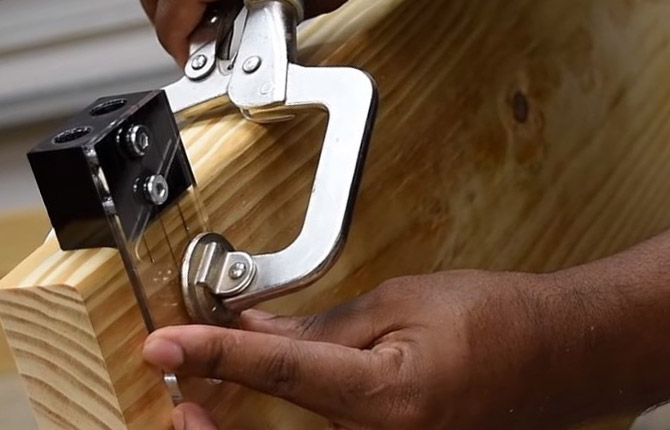
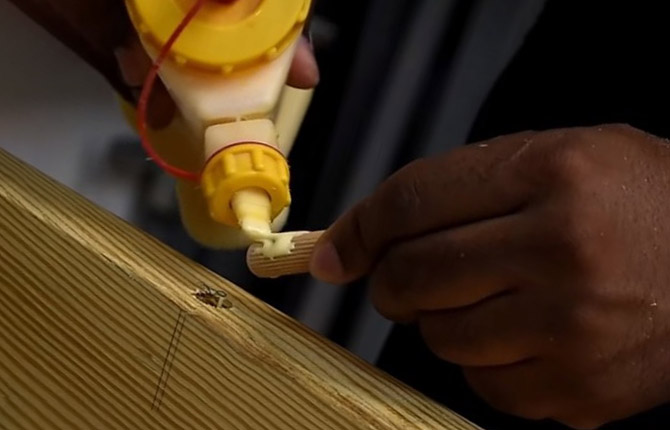



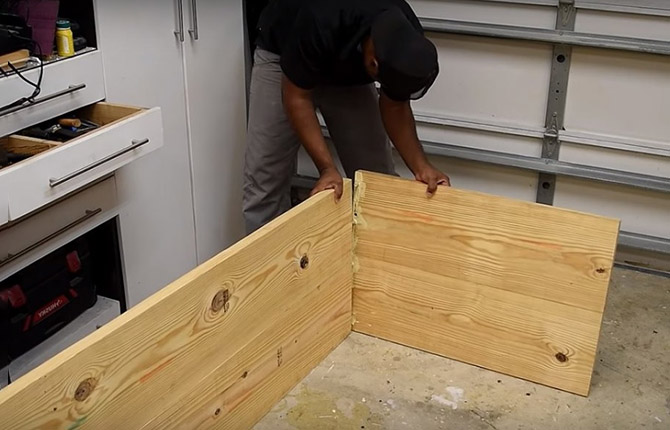
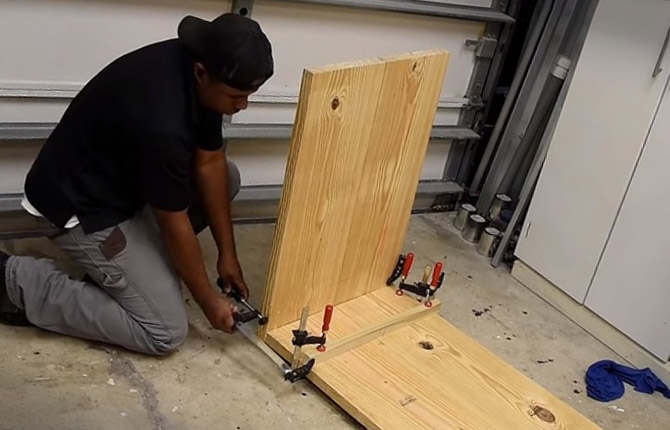





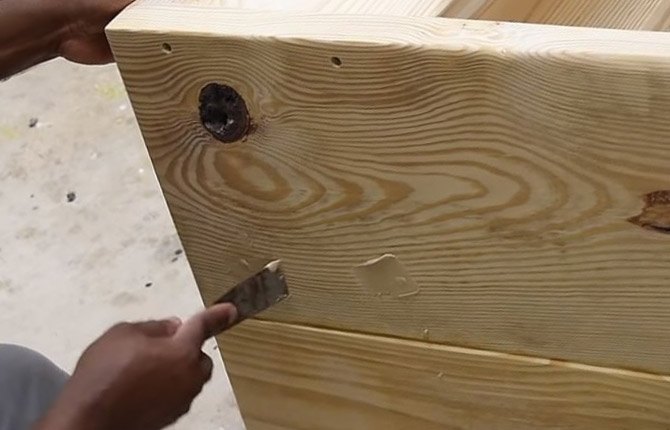


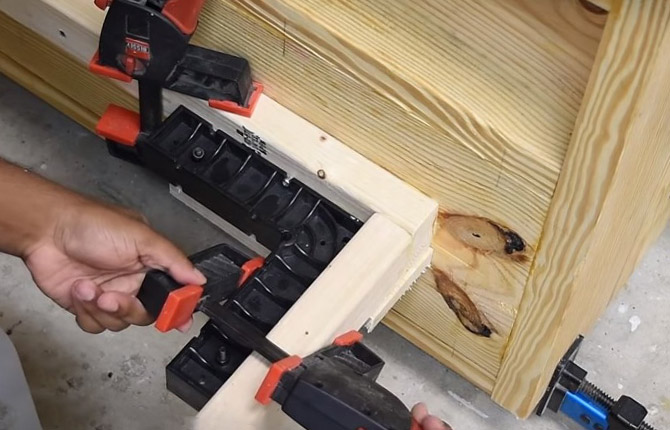





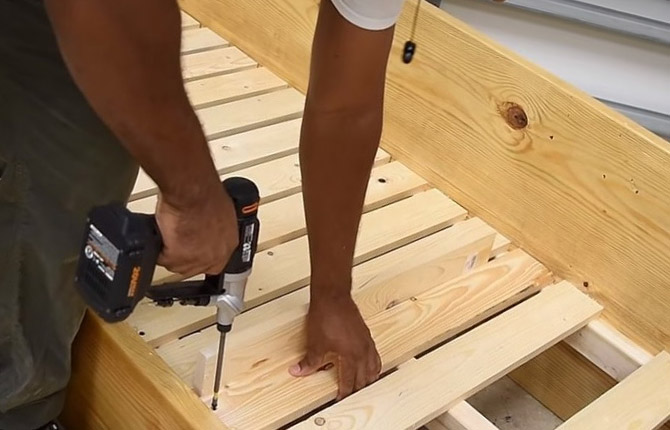





The entire frame is wooden, without a single steel angle or crab. I would strengthen the frame with metal plates. In general, everything is simple, you probably can’t make it any simpler. Only the boards will cost a pretty penny, it’s cheaper to take plywood.
Of all the things, I liked the sofa made of pallets, I’ll make one at the dacha for guests, let them spend the night.